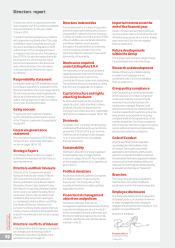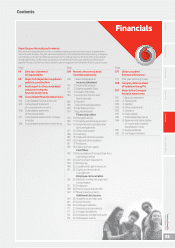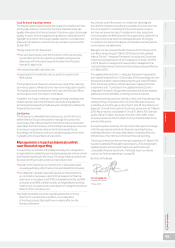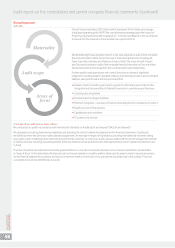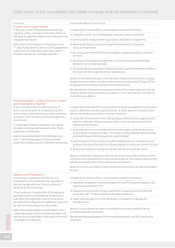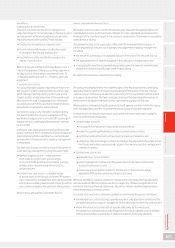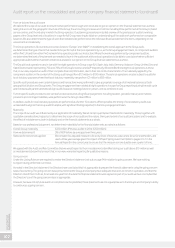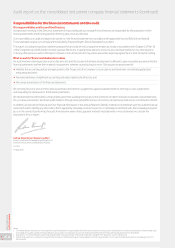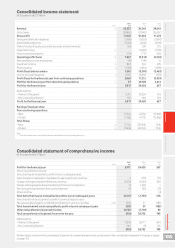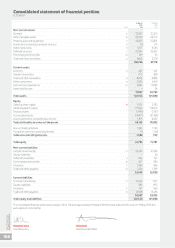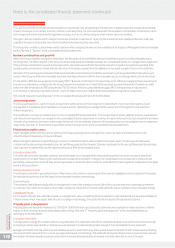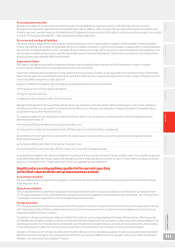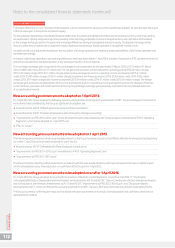Vodafone 2015 Annual Report Download - page 104
Download and view the complete annual report
Please find page 104 of the 2015 Vodafone annual report below. You can navigate through the pages in the report by either clicking on the pages listed below, or by using the keyword search tool below to find specific information within the annual report.
How we tailored the audit scope
We tailored the scope of our audit to ensure that we performed enough work to be able to give an opinion on the nancial statements as a whole,
taking into account the geographic structure of the Group, the accounting processes and controls including those performed at the Group’s shared
service centres, and the industry in which the Group operates. Our planning procedures included a review of the predecessor auditor’s working
papers at the Group level and at locations in scope for full Group reporting to obtain an understanding of the audit work performed on comparative
balances. We also determined the type of work that needed to be performed on the individual nancial statement line items, depending on risk
assessment and materiality.
The Group operates in 26 countries across two divisions; “Europe” and “AMAP”. In establishing the overall approach to the Group audit,
we determined the type of work that needed to be performed at the local operations by us, as the Group engagement team, or component auditors
within PwC UK and from other PwC network rms operating under our instruction. Where the work was performed by component auditors,
we determined the level of involvement we needed to have in the audit work at those local operations to be able to conclude whether sufcient
appropriate audit evidence had been obtained as a basis for our opinion on the Group nancial statements as a whole.
The Group’s local operations vary in size with the eight operations in Group scope (UK, Spain, Italy, India, Germany, Vodacom Group Limited, Ono and
Kabel Deutschland) representing 75% and 78% of the Group’s revenue and AOP respectively. We identied these eight local operations as those
that, in our view, required an audit of their complete nancial information, due to their size or risk characteristics. The materiality applied by the
component auditors in the context of the Group audit ranged from £12 million to £100 million. These local operations are also subject to audits for
local statutory purposes where their local statutory materiality ranges from £2 million to £83 million.
Specic audit procedures over certain balances and transactions were performed to give appropriate coverage of all material balances at both
geographical division and Group levels. The Group engagement team visited all eight operations in scope for Group reporting during the audit cycle
and the lead audit partner attended all eight audit clearance meetings (seven in person, one via conference call).
Further specic audit procedures over central functions and areas of signicant judgement, including taxation, goodwill, treasury and material
provisions and contingent liabilities, were performed at the Group’s Head Ofce.
In addition, audits for local statutory purposes are performed at a further 15 locations. Where possible, the timing of local statutory audits was
accelerated to align to the Group audit timetable, with signicant ndings reported to the Group engagement team.
Materiality
The scope of our audit was inuenced by our application of materiality. We set certain quantitative thresholds for materiality. These, together with
qualitative considerations, helped us to determine the scope of our audit and the nature, timing and extent of our audit procedures and to evaluate
the effect of misstatements, both individually and on the nancial statements as a whole.
Based on our professional judgement, we determined materiality for the nancial statements as a whole as follows:
Overall Group materiality £220 million (Previous auditor in 2014: £250 million).
How we determined it 5% of AOP before tax averaged over three years.
Rationale for benchmark applied We consider this adjusted measure to be a key driver of business value and a focus for shareholders, and
used a three year average given the impact of Project Spring investment (refer to pages 6 to 7 in the
Annual Report) in the current year to ensure that the measure is more durable over a period of time.
We agreed with the Audit and Risk Committee that we would report to them misstatements identied during our audit above £10 million as well
as misstatements below that amount that, in our view, warranted reporting for qualitative reasons.
Going concern
Under the Listing Rules we are required to review the Directors’ statement, set out on page 94 in relation to going concern. We have nothing
to report having performed our review.
As noted in the Directors’ statement, the Directors have concluded that it is appropriate to prepare the nancial statements using the going concern
basis of accounting. The going concern basis presumes that the Group and Company have adequate resources to remain in operation, and that the
Directors intend them to do so, for at least one year from the date the nancial statements were signed. As part of our audit we have concluded that
the Directors’ use of the going concern basis is appropriate.
However, because not all future events or conditions can be predicted, these statements are not a guarantee as to the Group’s and Company’s ability
to continue as a going concern.
Vodafone Group Plc
Annual Report 2015
102
Audit report on the consolidated and parent company nancial statements (continued)


